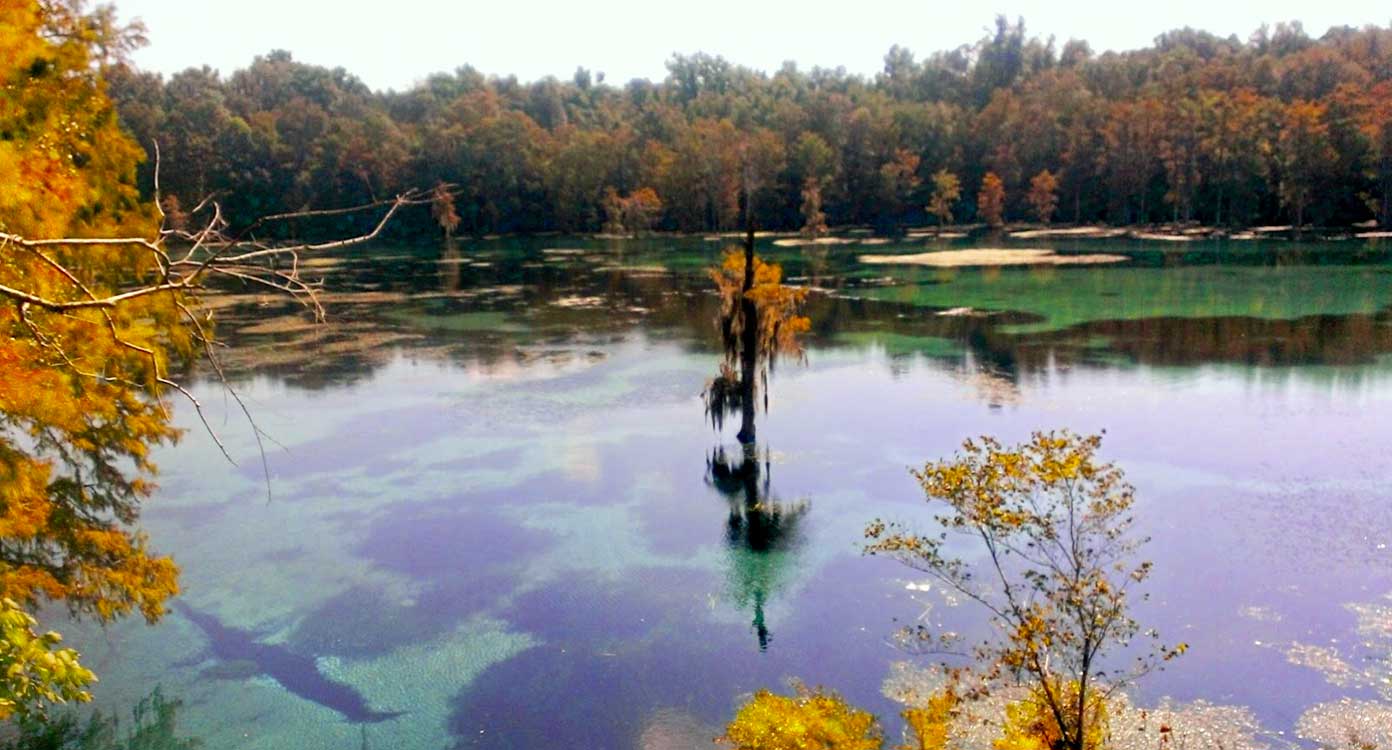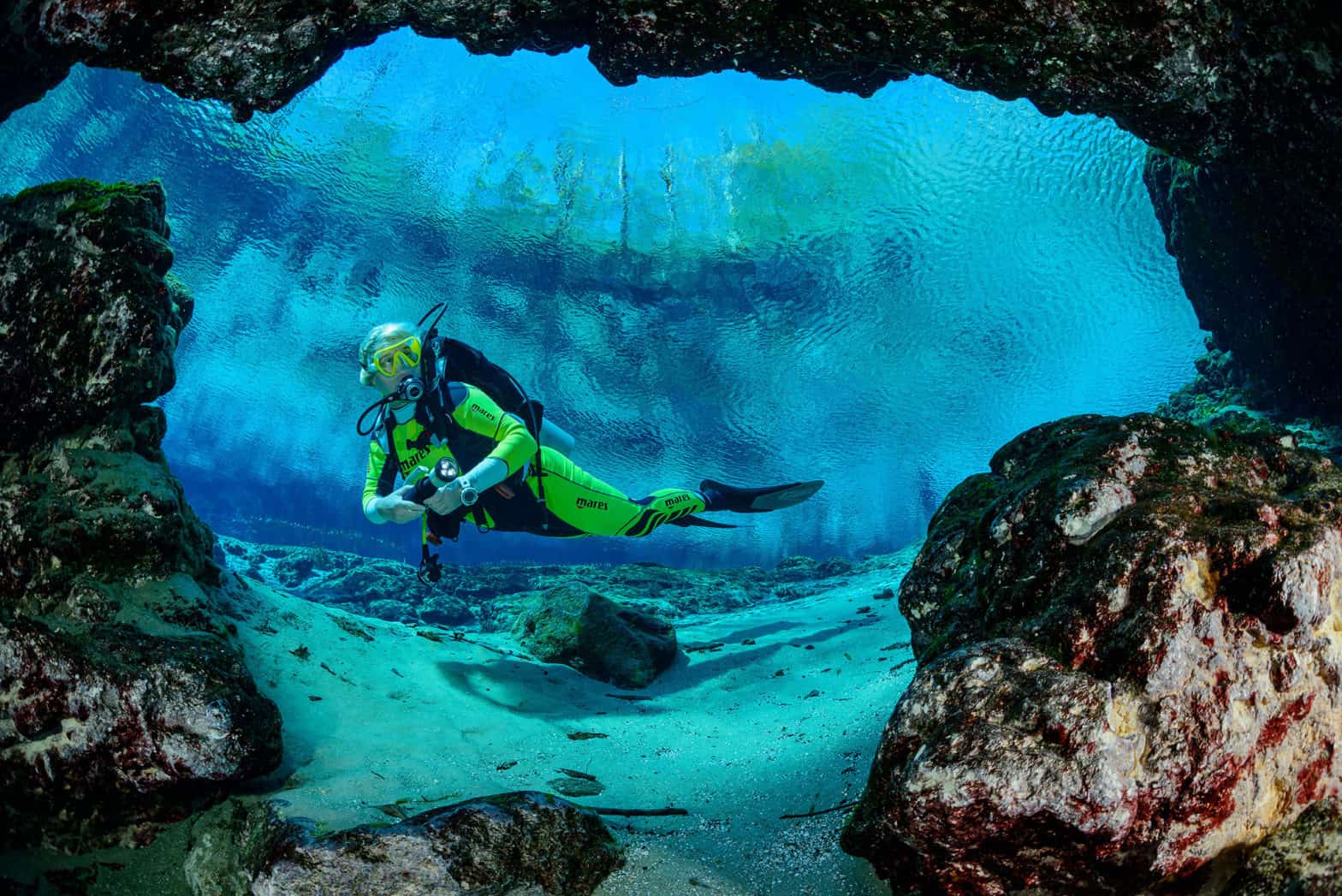*This post may contain affiliate links. As an Amazon Associate we earn from qualifying purchases.
Cave diving is a scuba diver’s dream. Most sea caverns play host to countless relics of the past or awe-inspiring natural features. Best of all, the artifacts and seascapes to be found while cave diving is sometimes completely unexplored. This makes cave diving a thrill unlike any other.
On the downside, cave diving can be an extremely technical challenge. In contrast with easier entry-level waters, sea caves are notorious for having difficult surfaces and tight spaces that are hard to maneuver. As a result, some caves are reserved for only the most skilled scuba divers.
Did you know that Florida is home to some of the world’s best diving caves? In Florida, cavern diving is unparalleled anywhere else in North America. With hundreds of grottos and caves to choose from, Florida is a beautiful destination for diver interested in taking their diving practice to the next level.
In this article, we break down the top cave diving Florida locations. And, to make it easy for you, we ranked each location according to difficulty. This way, both veteran and novice divers can benefit from the unique seascapes known to Floridian waters.
Florida Cave Diving 101

There are many scuba diving dangers, and several more unique to cave diving. Clearly, scuba diving is no picnic. Every time we strap on our scuba set and hook up our breathing tanks, we assume many risks. They include but are not limited to, barotrauma (e.g. middle ear pressure trauma), decompression sickness, oxygen toxicity, and attacks from sea life.
Diving is no walk in the park, and neither is cave diving. Since cave diving is a form of penetrative diving, the diver cannot rapidly surface due to the presence of the cave’s ceiling. Therefore, cave divers need to retrace their steps to exit the cave. Plus, cave dives are typically deeper than most which also comes with its share of hazards and safety risks.
It is no surprise that cave diving is one of the world’s deadliest sports. In Florida, cave diving is usually marked by high outflows, strong currents, and reduced air pressure. For some divers, this can lead to early exhaustion and improper breathing gas management. As a rule, Florida divers need to be extra careful when navigating the Sunshine State’s beautiful waters.
So, You Want to Cave Dive in Florida?
The great state of Florida is home to many blue lagoons, grottos, springs, dens, and various underwater caves. If you look at a map of Florida, you will quickly notice that it is a haven for divers. Flanked by both the Gulf of Mexico and the Atlantic Ocean, there is no shortage of warm water destinations for undersea exploration.
And, unlike the Caribbean or offshore sites, Florida cave diving is usually accessible via a day’s commute. Most Americans have the luxury of being able to make it out to Florida’s gorgeous coast within a single day of driving. This makes Floridian sea caves highly accessible compared to other top-tier diving caves.
The northern region of Florida is the most popular cave diving area in the world. Many of the world’s greatest divers learned to cut their teeth in the depths of North Florida’s sea caves. Do you think you have what it takes to cave dive Florida? Check out our list of the state’s best diving spots.
Devil’s Den
No, not Devil’s Den State Park, which is in Florida. Rather, Devil’s Den is a cave located near Williston, Florida. Like most of Florida’s caves, Devil’s Den is found in its northern region on the coast of the Gulf of Mexico.
Devil’s Den was formed by a phenomenon known as a “Karst Fenster.” The Karst Fenster is a geomorphic formation that is caused by carbonate bedrock when it dissolves. As a result, a spring is formed at the center of the formation which also causes a sinkhole.
The Devil’s Den is owned by a private organization that hosts their own diving training facility out of the cave. For your convenience, they also offer equipment rentals and other gear for more experienced users. This makes the Devil’s Den a great choice for entry-level divers. To find out more about Devil’s Den Florida, check out their website here.
Blue Grotto
The Blue Grotto Dive Resort features the largest clear water diving cave is north Florida. Located near Williston, Florida, the Blue Grotto Florida is a true natural wonder. Central to the resort is a massive underwater cave suitable for divers both intermediate and advanced in skill.
From all over the world, divers flock to the vast crystal-blue cavern at the Grotto. One of the key attractions of the Grotto is the fact that it is so well preserved. In its current state, the Grotto appears to be practically untouched by man. Since its opening, the resort has maintained the pristine aesthetic of the water, the silt, and the cave.
To explore the Blue Grotto, divers must first secure their Open Water Diving Certification. However, this is standard among most licensed scuba diving sites nowadays. Additionally, the Blue Grotto is rated as one of the safest sea caves for novice divers as there are a limited number of hazardous rocks and sea lifeforms in the water.
To find out more about the Blue Grotto, and to discover why it is considered some of the best cave diving Florida has to offer, check out their website here. Remember, the resort is family friendly and features loads of BBQ and campsites for overnight stays. This makes Blue Grotto one of our all-time favorite cave diving locations.
Devil’s Millhopper Geological State Park
Devil’s Millhopper Geological State Park is one of the many Florida State Parks located in the northern region of the state. Found near Gainesville, Devil’s Millhopper was established in 1974 and features twelve of the largest springs in Florida. It is preserved and operated by the Florida Department of Environmental Protection.
Geologically, the Millhopper is defined by large outcroppings of limestone and many large sinkholes. Consequently, the Millhopper is visually distinct among Florida’s many cave diving locations. The Millhopper gets its name from the wide sinkhole found at its middle, which looks like a typical hopper in a mill. To some, the sinkhole also looks like it is wearing a devil’s horns.
Since coming under the protection of the Florida Department of Environmental Protection, the sinkhole is off-limits to guests looking to explore its depths. This is unfortunate because it would otherwise rank highly on our list of top cave diving Florida locations. However, there are many springs near the Millhopper that might offer a suitable alternative.
Ginnie Springs
Ginnie Springs is one of the pinnacle features of the northern Florida cavern system. Located northwest of High Springs, Ginnie contains crystal clear cold water with smooth limestone seafloors and sandy beaches. Ginnie is truly a delight for cave divers both new and experienced.
As a privately-owned park, Ginnie Springs is available for access to any certified diver, canoer, or snorkeller. The park owners also provided on-site dive training, gear rentals, and camping equipment. We find that the level of accessibility of Ginnie Springs is unparalleled, and its beauty is seldom matched.
It’s no surprise that Ginnie ranks among our favorite cave diving Florida locations. If you are interested in making a trip down to Ginnie Springs, check out their website here. You are bound to find that Ginnie is fun for the whole family.
Manatee Springs State Park

Manatee Springs State Park is in Levy County, Florida, with the closest city being Chiefland to its east. Established as a state park in 1971, Manatee Springs has unrivaled accessible sinkholes and wetlands out of any other Florida-owned park.
In fact, scuba diving is one of Manatee Springs’ main attractions. However, cave access requires Full Cave Certification, so the cave diving portion is not recommended for anyone but veteran divers. Experienced divers will love Manatee Springs, as the natural seascape provides lovely views and mostly unobstructed diving terrain as you navigate Catfish Hotel.
For more about Manatee Springs diving restrictions, check out their website here. Note that Park Rangers strictly enforce a no-contact rule between divers and manatees (sorry!).
Merritt’s Mill Pond

Near Graceville, Florida lies Merritt’s, Mill Pond. Renowned for its natural beauty and clear-blue sea caverns, Merritt’s a local treasure. Not only does Merritt’s Mill provide great diving experience, but also excellent fishing, camping, and swimming accommodations. Together, these qualities make Merritt’s one of our favorite cave diving sites in Florida.
More information about Merritt’s Millpond and its many diver-friendly sinkholes can be found at the Walton Outdoors website. At Merritt’s, you will find that the colossal limestone cavern of nearly 5,000 feet is among the most beautiful in the great state of Florida.

